Improved Active Islanding Detection Technique for Multi-Inverter Power System
Jie Zhang| Yu-Hua Cheng | Kai Chen | Gen Qiu
Abstract—Due to the increased penetration of multi-inverter distributed generation (DG) systems,different DG technologies,inverter control methods,and other inverter functions are challenging the capabilities of islanding detection.In addition,multi-inverter networks connecting the distribution system point of common coupling (PCC)create islanding at paralleling inverters,which adds the vulnerability of islanding detection.Furthermore,available islanding detection must overcome more challenges from non-detection zones (NDZs) under reduced power mismatches.Therefore,in this study,a new method called parameter self-adapting active islanding detection was utilized to minimize the dilution effect and reduce NDZs in multi-inverter power systems.The method utilizes an active frequency drift (AFD) method and applies a positive feedback gain of adoption parameters,which significantly minimizes NDZs at parallel inverters.The simulation and experimental outcomes indicate that the proposed method can effectively weaken the dilution effect in multi-inverter networks connecting the distribution system PCC.
1.Introduction
Over the recent past,distributed generation (DG) has been a primary way to use renewable energy.Although this method has been intensively concerned and developed,there still are challenges to it,such as the increasing power generation and power quality requirements (e.g.,harmonic distortion and electromagnetic interference (EMI) limits).Among these,islanding detection is of special importance[1],[2].As an electrical phenomenon,islanding detection happens when parts of electric power systems are isolated from the main power grid.DG is called islanded DG if at all it is in isolated electric power systems.Actually,considering equipment integrity and personnel safety,unintentional islanding in DG operation should not be ignored in engineering[1].
In 2000,IEEE Standards Coordinating Committee designed corresponding standards detailed for gridconnected and islanded DG,including UL1741 (static inverter and charge controllers for use in photovoltaic systems)[3],IEEE Std.929-2000 (IEEE recommended practice for utility interface of photovoltaic (PV)systems)[4],and IEEE Std.1547-2003 (IEEE standard for interconnecting distributed resources with electric power systems)[5].The standards outline test procedures and set the limits for the grid parameters,which are shown inTable 1,whereVRMSis the root-mean-square voltage.

Table 1:Response to abnormal voltage (IEEE std.929-2000)
According to IEEE standards[3]-[5],islanded DG is required to be detected within two seconds.Therefore,being equipped with islanding detection is essential for DG.Islanding detection methods (IDMs) can be grouped into the following categories based on the detection techniques:Communication-based,passive,and active[6]-[11].
From these,passive techniques are typically utilized in power utilities.For passive islanding detection techniques,the incorporation of signal processing tools and intelligent classifiers has aided in solving the problem of large non-detection zones (NDZs) and threshold setting[12].
But with the increasing penetration of multi-inverter DG systems into the distribution network,there are concerns being raised again regarding the possibility of multi-inverter unintentional islanding.Recently,researchers started to focus on multi-inverters’ islanding detection.
Reference [13] discussed the islanding detection function and the fault ride through function on the asynchronous interconnecting inverter of hysteresis control in a digital grid.Reference [7] discussed the capabilities of inverters with passive IDM and active frequency drift (AFD) IDM,and also analyzed interference.Reference [14] analyzed small-signal stability and suggested parameter selection for multiinverter systems using the Sandia frequency shift (SFS) technique.Reference [15] showed that mutual interference exists in these multi-inverter systems equipped with impedance,and under some circumstances,islanding cannot even be detected.
To decrease NDZs,researchers proposed to detect islanding conditions by calculating the rate of the change of the voltage phase angle of the point of common coupling (PCC) by the phase-locked loop in inverter controllers[16].Reference [17] proposed choosing different SFS parameters that can eliminate NDZs in multi-inverter systems.Reference [18] discussed the mutual interference among current-disturbing positive feedback (CDPF) IDM,active frequency drift positive feedback (AFDPF) IDM,and SFS IDM in multi-inverter systems.Paralleling with one or more passive IDMs minimized the amount of frequency drifting using active IDM,thereby increasing NDZs[19],[20].
In this study,parametric adaptive AFD IDM is shown.The new technique can definitely weaken the dilution effect and reduce NDZs in multi-inverters.The simulation and experiment outcomes show that the proposed method can effectively weaken the dilution effect in multi-inverter networks connecting the distribution system PCC.
2.Traditional Active IDMs
2.1.AFD and SFS IDMs
AFD is affected by adding a short period of zero time into the output current of the inverter,as shown inFig.1.
The period of zero time isTz.The period of the voltage waveform isTgrid.Thus,the “chopping fraction” (cf)is defined as

The parameter cf allows the islanding detection to drift up (or down) the frequency of the voltage under the islanding parameters.However,due to the fixed value of cf,traditional AFD has large NDZ and is slow to meet the islanding detection time limit.
So as to solve the problem of AFD IDM,the Sandia laboratory proposed improved SFS,also known as AFDPF IDM.cf is not a constant,but a variable with the frequency of the previous cycle,such as
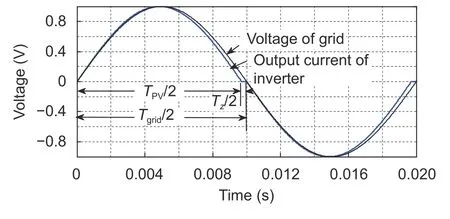
Fig.1.Example of a waveform using AFD.

whereKrepresents the positive feedback gain,which is the initial chopping factor.
The output current of the inverter is derived by

In comparison with the AFD method,SFS IDM adds the positive feedback gain of the frequency into the current disturbance.The greater the difference between the frequency and the standard frequency,the larger the cf.In the normal grid,if the voltage frequency deviates from the standard frequency,cf slightly increases.However,the output voltage is not affected in any way.cf will stabilize and not further increase.Whereas,after PCC is disconnected,due to the positive feedback effect,the frequency of the output voltage will increasingly deviate from the nominal value.Therefore,if the frequency goes past the boundary,islanding is successfully detected.
2.2.Dilution Effect of SFS in Multi-Inverter Power System
The effectiveness of the AFDPF method is usually demonstrated by steady-state NDZs represented in a load parameter space.The following approach is used to measure islanding-detection NDZs of multi-inverter systems.
The DG system comprises two parallel inverters.The first inverter adopts IDM of SFS and the second inverter adopts IDM of over/under frequency protection (OFP/UFP).The power ratio of the first inverter using SFS isGSFSpu,and the power ratio of the second inverter using OFP/UFP isGOFP/UFPpu.The output current of each inverter is shown as

Referring to (4) and (5),the total current of the two parallel inverters is given by

The angle between the current and the voltage can be calculated as

where


Referring to (8),whenGOFP/UFPpuis not equal to zero,tan2βis greater than zero.Furthermore,φinvsis less thanφSFS,and the effectiveness of the SFS method is weakened.The DG-based multiple parallel inverters heighten the vulnerability of islanding detection.
3.Improved AFD IDM
3.1.Parameter Self-Adapting SFS Method
In order to improve the performance of SFS on multiple parallel inverters,improved SFS islanding detection is presented.The positive feedback parameter of SFS is dynamically changed in the new method,as follows:

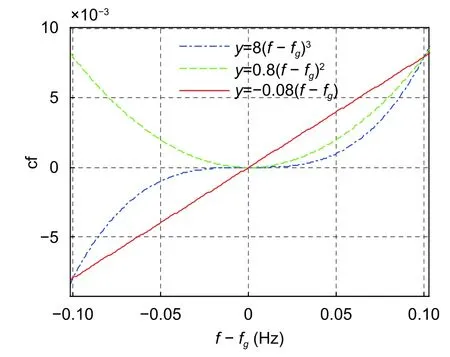
Fig.2.cf of SFS and parameter self-adapting SFS.
whereK0is the initial positive feedback parameter.Kincreases with the increase in the frequency deviation.
The current of the inverter is given by

Assuming that the initial cf is 0,the comparison of cf of SFS and improved SFS is shown inFig.2.
When the grid is normally connected,the fluctuation of the grid frequency is less than 0.1 Hz.At this moment,8(f−fg)3is much smaller than 0.08(f−fg).This indicates that improved SFS IDM has less impacts on the total harmonic distortion of the current.
On the other hand,when the fluctuation deviation is more than 0.1 Hz under the grid disconnecting,8(f−fg)3rapidly rises (or falls),faster than 0.08(f−fg).This reflects that the frequency is rapidly shifted,and cf increases rapidly.Therefore,islanding detection is easier and faster.
3.2.Analyzing NDZs
By using the parameter self-adapting SFS islanding detection algorithm,the output voltage of the inverter phase is shown as

Then,the resonant frequency is shown as

whereQfis the quality faction.
According to the threshold [fmin,fmax] of the grid frequency,the resonant frequency of the NDZs boundary can be calculated withfminandfmax:


Fig.3shows NDZs of the parameter selfadapting SFS islanding detection algorithm.Obviously,if you compare NDZ of traditional and self-adapting parameters (cf0=0),NDZ of the latter is smaller.The positive feedback gain is set to beK0=7.When the load quality factor is less than about 250,NDZs of the improved SFS method have disappeared.

Fig.3.NDZs of the parameter self-adapting SFS islanding detection algorithm.
4.Dilution Effect of Parameter Adaptive SFS in Multi-Inverter Power System
4.1.System with Parameter Self-Adapting SFS and Passive IDM Inverters
The DG system is composed of two parallel inverters.The first inverter adopts IDM of parameter selfadapting SFS and the second inverter adopts IDM of OFP/UFP.The power ratio of the first inverter using SFS isGSFS_MODpu,and the power ratio of the second inverter using OFP/UFP isGOFP/UFPpu.
Referring to (7),the angle between the current and the voltage can be calculated as follows:

where

Then,the resonant frequency is shown as

When the power ratio is 1:1,it can get the resonance frequency equation,and deduce NDZs of the inverter system,as shown inFig.4.The positive feedback gain is set to beK0=7 with parameter self-adapting SFS andK0=0.07 with SFS,and the initial chopping fraction is set to be cf0=0.
FromFig.4,we can observe that when the resonant frequency is constant,improved SFS IDM obviously minimizes NDZs and makes islanding detection more effective.For example,when the resonant frequency is 50 Hz,NDZ using the improved SFS technique is nonexistent where the quality factor range is 2 to 39.

Fig.4.NDZs of parallel inverters using parameter SFS and OFP/UFP (the ratio of power is 1:1).
4.2.System with Parameter Self-Adapting SFS and CDPF IDM Inverters
The DG system comprises two parallel inverters.The first inverter adopts IDM of parameter self-adapting SFS and the second inverter adopts IDM of CDPF.The power ratio of the first inverter using SFS isGSFS_MODpu,and the power ratio of the second inverter using CDPF isGCDPFpu.Then,the total output current of the two parallel inverters is

The output current is expressed as an amplitude and phase form:

Among them,

When the power ratio is 1:1,the load phase angle and the current phase angle are utilized to draw NDZ,as shown inFig.5.The positive feedback gain is set to beK0=7 with parameter self-adapting SFS andK0=0.07 with SFS,the positive feedback gain is set to beα=3 with CDPF,and the initial chopping fraction is set to be cf0=0.
From the figure we can see,when the resonant frequency is constant,the improved SFS islanding detection technique definitely minimizes NDZs and makes islanding detection better under different grid voltages.
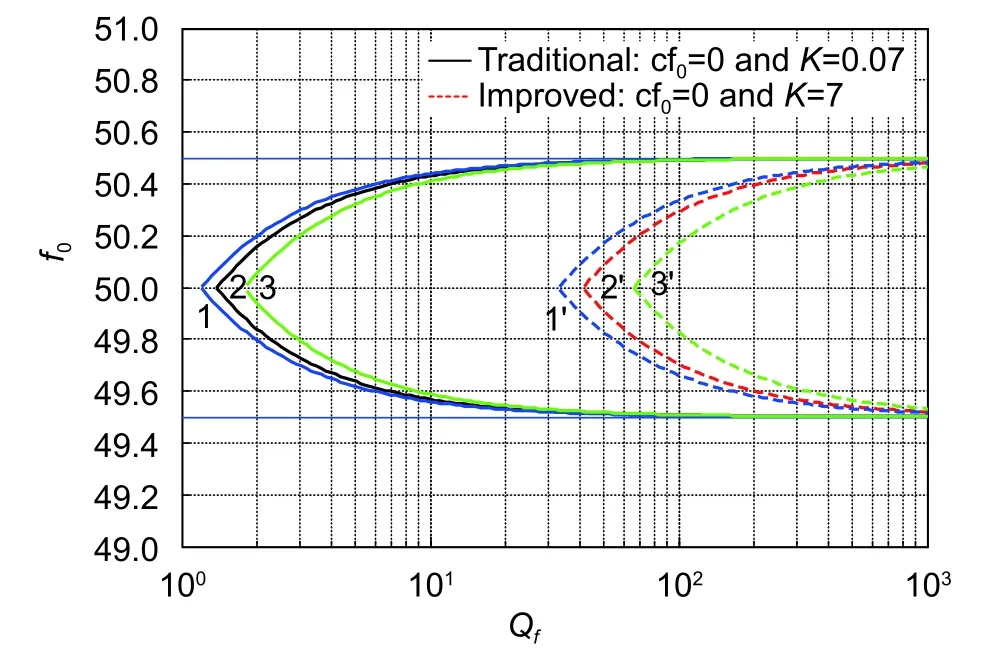
Fig.5.NDZs of parallel inverters using SFS and CDPF(the ratio of power is 1:1.Diagram:1,2,and 3 show NDZs of SFS under different grid voltages;1',2',and 3' show NDZs of improved SFS under different grid voltages of 242 V,220 V,and 187 V).
5.Simulation and Experiment
5.1.Experiment with Single Inverter
First,the effect of the parameter self-adapting SFS is confirmed in a single inverter system.The inverter energizes a nominal power of 3.1 kW at a nominal single-phase voltage of 220 V with 50 Hz.The other conditions are listed inTable 2.
If we compared the time of detecting islanding,the inverter using parameter self-adapting SFS stops output power after 6.25 grid cycles as shown inFig.6 (b),but the inverter using SFS stops output power after 6.75 grid cycles as shown inFig.6 (a).Therefore,the comparison shows that the speed of islanding detection is improved based on parameter self-adapting SFS presented in this study.
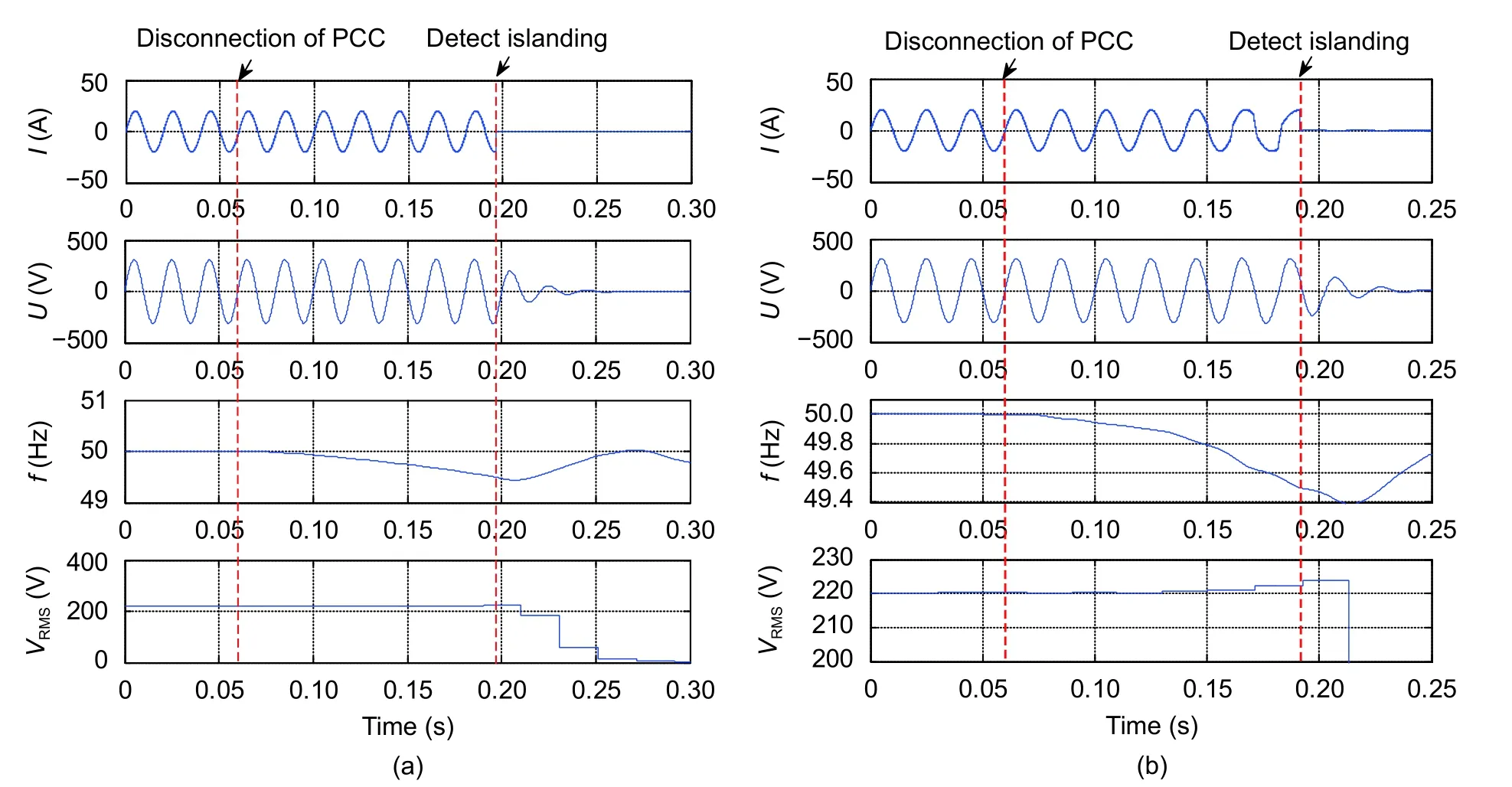
Fig.6.Islanding detection process for single inverter:(a) SFS IDM and (b) parameter self-adapting SFS IDM.
5.2.Improved SFS in Multi-Inverter Power System
5.2.1.System with Parameter Self-Adapting SFS and OFP/UFP IDM Inverters
The DG system comprises two parallel inverters.The first inverter adopts IDM of parameter self-adapting or traditional SFS and the second inverter adopts IDM of OFP/UFP.The main parameters are listed inTable 2.

Table 2:Main parameters of the single inverter
The islanding detection process of parallel inverters using parameter SFS and OFP/UFP is shown inFig.7.The positive feedback gain is set to beK0=7 with parameter self-adapting SFS andK0=0.07 with SFS,and the initial chopping fraction is set to be cf0=0.As shown inFig.7 (a),under two parallel inverters using SFS and OFP/UFP,the frequency is not sufficient for the islanding protection threshold (50 ± 0.5 Hz) in case of islanding.As shownFig.7 (b),under two parallel inverters using parameter self-adapting SFS and OFP/UFP,the frequency rapidly falls,and islanding is detected effectively.
5.2.2.System with Parameter Self-Adapting SFS and CDPF IDM Inverters
The DG system comprises two parallel inverters.The first inverter adopts parameter self-adapting or traditional SFS IDM and the second inverter adopts CDPF IDM.The main parameters are listed inTable 2.
The islanding detection process of parallel inverters using parameter SFS and CDPF is shown inFig.8.The positive feedback gain is set to beK0=7 with parameter self-adapting SFS andK0=0.07 with SFS,the positive feedback gain is set to beα=3 with CDPF,and the initial chopping fraction is set to be cf0=0.As shown inFig.8 (a),under two parallel inverters using SFS and CDPF,the frequency cannot reach the islanding protection threshold (50 ± 0.5 Hz) in case of islanding.As shown inFig.8 (b),under two parallel inverters using parameter self-adapting SFS and CDPF,the frequency rapidly falls,and islanding was effectively detected.

Fig.7.Islanding detection process of parallel inverters using SFS and OFP/UFP:(a) SFS IDM and (b) parameter self-adapting SFS IDM.
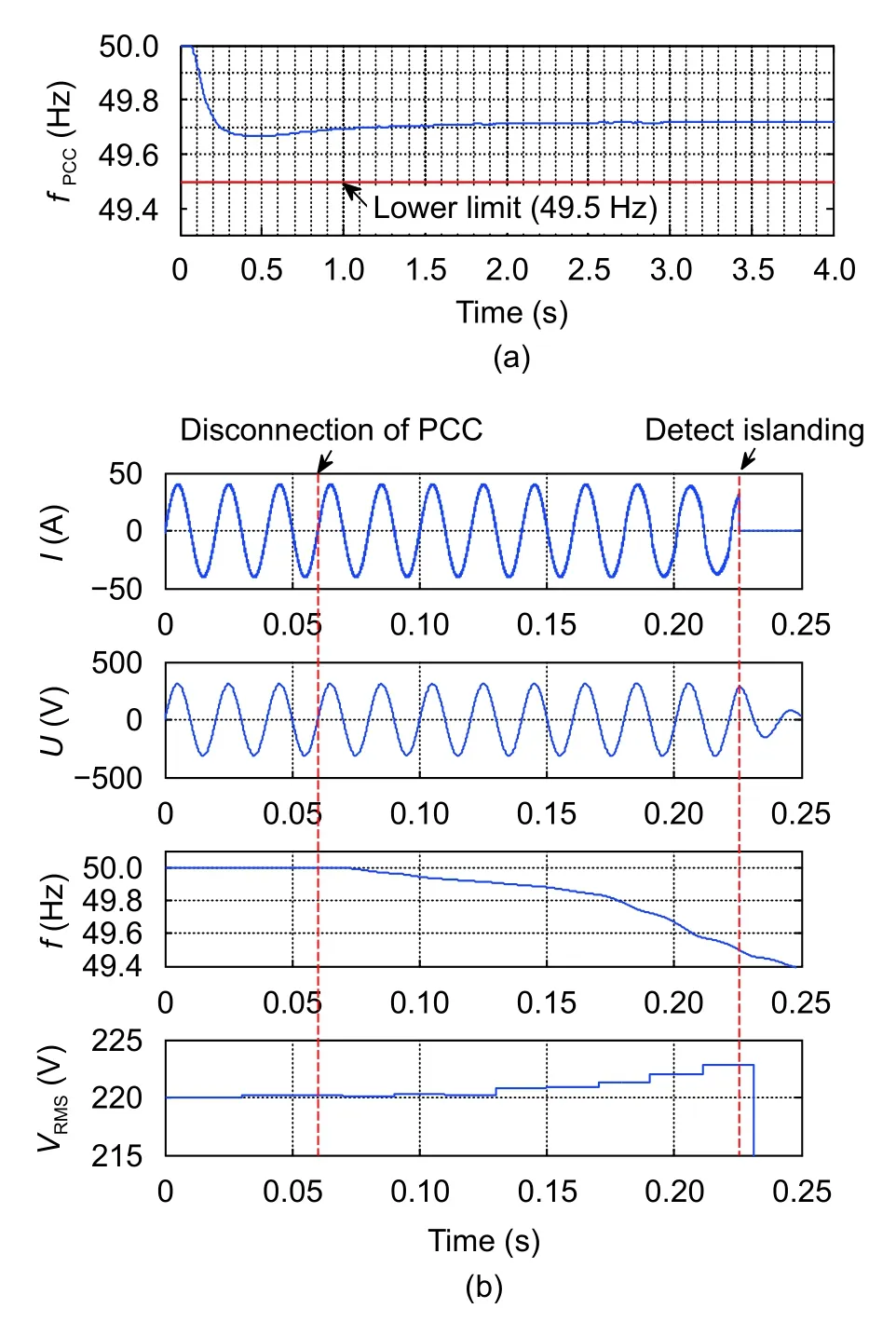
Fig.8.Islanding detection process of parallel inverters using SFS and CDPF:(a) SFS IDM and (b) parameter selfadapting SFS IDM.
5.3.Results and Analysis
Through analysis in subsections 5.1 and 5.2,the proposed parameter self-adapting SFS IDM can effectively detect islanding,and the speed of islanding detection is enhanced in single inverter.Moreover,the proposed method decreases NDZs and weakens the dilution effect in multi-inverter systems with varying islanding detection techniques.
6.Conclusions
In this paper,mutual interference of IDM in multi-inverter systems was analyzed.Then parameter selfadapting SFS IDM was proposed.The proposed method can obviously weaken the dilution effect and decrease NDZs in multi-inverter systems.Simulation and experiment results prove that endorsed IDM has satisfactory performance.
Disclosures
The authors declare no conflicts of interest.
 Journal of Electronic Science and Technology2021年2期
Journal of Electronic Science and Technology2021年2期
- Journal of Electronic Science and Technology的其它文章
- Perovskite Single Crystals:Synthesis,Properties,and Applications
- Progress and Prospects of Hydrogen Production:Opportunities and Challenges
- Big Data-Based Transformer Substation Fault Prediction Method
- Comparison of Khasi Speech Representations with Different Spectral Features and Hidden Markov States
- Neural Network Based Adaptive Tracking of Nonlinear Multi-Agent System
